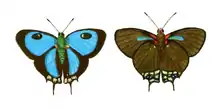Great purple hairstreak
The great purple hairstreak (Atlides halesus), also called the great blue hairstreak, is a common gossamer-winged butterfly species in parts of the United States. It is actually a Neotropical species; its North American range only includes the warm-temperate and subtropical parts of that continent, and it ranges southwards almost to the Isthmus of Panama. The type specimen, however, was shipped to Europe from the Colony of Virginia, probably around the time of the United States Declaration of Independence.
| Great purple hairstreak | |
|---|---|
 | |
| The type specimen from above (left) and below | |
| Scientific classification | |
| Kingdom: | Animalia |
| Phylum: | Arthropoda |
| Class: | Insecta |
| Order: | Lepidoptera |
| Family: | Lycaenidae |
| Genus: | Atlides |
| Species: | A. halesus |
| Binomial name | |
| Atlides halesus | |
.jpg.webp)
The common names refer to the butterfly's two main colors – dusky purple on the underside, and iridescent blue above. Particularly the males are very colorful in flight – brilliant blue and velvety black, with bright red and golden markings – but when sitting down they show their inconspicuous dusky purple underside. Several subspecies are recognized.
Its caterpillar larvae feed on the mistletoe genus Phoradendron.
Life History

Males of this species wait for possible mates for mating on tall perches such as tees. The mated females then choose mistletoe plants for oviposition. The eggs are laid in either groups or by themselves on the host plant.[3] Once hatched, the larvae do not consume their egg shells as a first source of nutrition as other species of butterflies do.[4] Instead, they go straight into feeding on their host plant's leaves and male flowers until fully grown.[5] Next, the larvae pupate in well-protected areas close to the base of trees and emerge as the adult stage butterfly.[4]
The species gains protective toxins from their larval host plants that stay in their system into adulthood.[4] The larvae are not colored in a way that warns predators of this, they instead match the green color and round shape of their host plant's foliage. Adult butterflies, however, do have their orange and black colorings to signal the toxins and even have a behavior of rubbing their wings together. This draws attention to the markings on their back wings that serve as a "false head."[3]
The great purple hairstreak has various natural enemies including parasitoid wasps, the species being Apaanteles sp. as well as Metadontia amoena.[4]
References
- "NatureServe Explorer 2.0 - Atlides halesus, Great Purple Hairstreak". explorer.natureserve.org. Retrieved 7 May 2020.
- "Great Purple Hairstreak, Atlides halesus (Cramer, 1777)". Butterflies and Moths of North America. Retrieved April 2, 2012.
- "Great Purple Hairstreak - Alabama Butterfly Atlas". alabama.butterflyatlas.usf.edu. Retrieved 2020-12-16.
- "great purple hairstreak - Atlides halesus (Cramer)". entnemdept.ufl.edu. Retrieved 2020-12-16.
- "Great Purple Hairstreak Atlides halesus (Cramer, 1777) | Butterflies and Moths of North America". www.butterfliesandmoths.org. Retrieved 2020-12-16.
External links
- Great purple hairstreak, Butterflies of North Carolina Online
- "Great purple hairstreak". Featured Creatures. University of Florida / Institute of Food and Agricultural Sciences.
- Many beautiful images of this species
- Very detailed rearing project
- Life cycle video on YouTube
